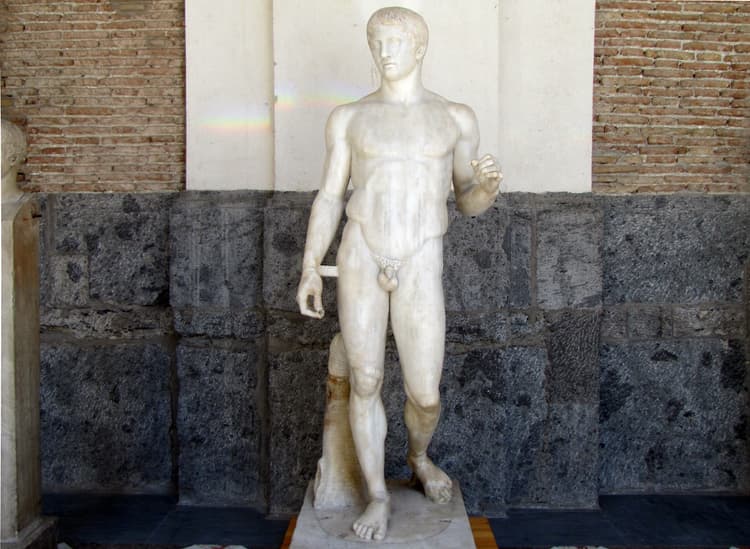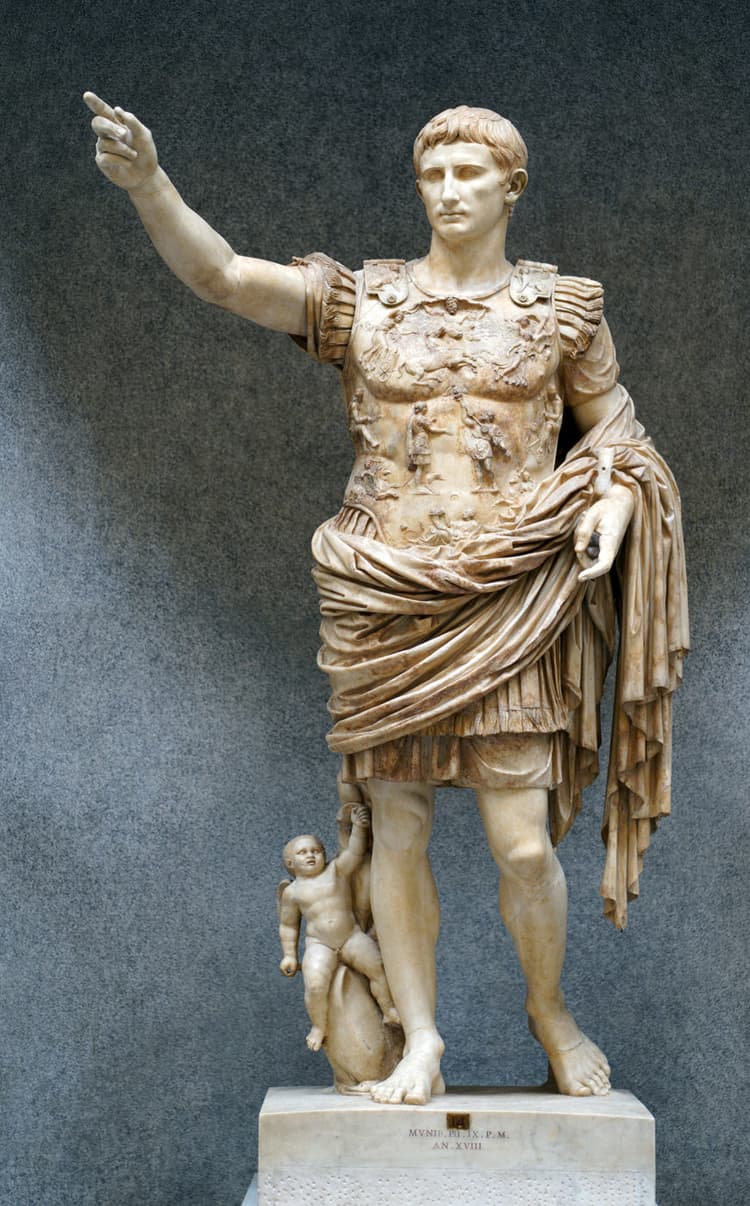Interactions Across Cultures in Ancient Mediterranean Art
Joseph Brown
7 min read
Listen to this study note
Study Guide Overview
This AP Art History study guide covers Ancient Mediterranean masterpieces, focusing on Archaic Greek (Anavysos Kouros), Classical Greek (Doryphoros), and Roman Imperial (Augustus of Prima Porta) sculptures. It also examines Roman architecture (Colosseum) and the cultural interactions between Greek and Roman art. Key terms include contrapposto, idealized human form, and Roman propaganda. The guide provides practice questions and exam tips covering multiple-choice, short answer, and free-response formats.
#AP Art History: Ancient Mediterranean Masterpieces - Your Ultimate Study Guide 🏛️
Hey there, future art historian! 👋 This guide is designed to be your go-to resource for acing the AP Art History exam, especially when you're reviewing the night before. Let's dive into some key works from the Ancient Mediterranean, focusing on what you really need to know. We'll make it engaging, easy to remember, and super effective. Let's get started!
#🏛️ Archaic Greek Sculpture: The Anavysos Kouros
#Key Features and Significance
- What is it? A marble statue of a young, nude male figure (kouros) from ancient Greece. Think of it as a super-buff dude from way back when.
- Purpose: Grave marker or dedicatory offering to gods. These weren't just pretty statues; they had a purpose.
- Key Characteristics:
- Realistic and detailed musculature achieved through incised lines.
- A contemplative, introspective facial expression, unlike the typical "archaic smile." 🤔
- Frontal pose with arms at the sides and one leg slightly forward.
- Significance: One of the best examples of Archaic Greek sculpture. It shows the early development of realistic human representation.
Remember "Kouros = Keen, Contemplative, and Carved" to recall its key features.

Anavysos Kouros, c. 530 B.C.E., marble, 6' 4" (National Archaeological Museum, Athens)
#🗿 Classical Greek Sculpture: The Doryphoros (Spear Bearer)
#Key Features and Significance
- What is it? A marble statue of a young, athletic male figure, likely a hoplite (soldier). Imagine a Greek god in training. 💪
- Purpose: To demonstrate ideal human proportions and the concept of contrapposto.
- Key Characteristics:
- Lifelike portrayal of the human form, emphasizing musculature and natural movement.
- Contrapposto stance: weight shifted to one leg, creating a sense of movement and dynamic tension. 🚶
- Idealized proportions, embodying the Greek concept of beauty.
- Significance: A prime example of Classical Greek sculpture. It embodies the pursuit of perfection and harmony in art.
Think "Doryphoros = Dynamic, Detailed, and Demonstrating Contrapposto" to remember its key features.

Polykleitos, Doryphoros (Spear-Bearer) or Canon, Roman marble copy of a Greek bronze, c. 450–440 BCE (Museo Archaeologico Nazionale, Naples)
#👑 Roman Imperial Sculpture: Augustus of Prima Porta
#Key Features and Significance
- What is it? A marble statue of the Roman Emperor Augustus. It's like a royal selfie, but in marble. 🤳
- Purpose: Political propaganda, portraying Augustus as a powerful, divine leader.
- Key Characteristics:
- Lifelike portrayal of Augustus, including his facial features and clothing.
- Idealized depiction of Augustus as strong and youthful, even though he was older.
- Inscription on the base emphasizing his divine status and support from the Roman people.
- The cupid at his feet and the breastplate are packed with symbolism. 💡
- Significance: An important example of Roman Imperial art, showcasing the use of art for political purposes.
Remember "Augustus = Awesome, Authoritative, and Artful Propaganda" to recall its key features.

Augustus of Primaporta, 1st century C.E., marble, 2.03 meters high (Vatican Museums)
#🏟️ Roman Architecture: The Colosseum
#Key Features and Significance
- What is it? An oval amphitheater in Rome, built during the Flavian dynasty. Think of it as the ancient Roman Super Bowl stadium. 🏈
- Purpose: Entertainment, including gladiatorial contests, animal hunts, and mock naval battles. A place for spectacle and public gatherings.
- Key Characteristics:
- Largest amphitheater in the world, capable of seating up to 50,000 spectators.
- Architectural design includes 80 arched entranceways, four levels of seating, and an underground network of tunnels and chambers.
- Use of concrete and innovative engineering techniques.
- Significance: An iconic symbol of Roman civilization, showcasing their engineering and architectural skills.
Think "Colosseum = Colossal, Concrete, and Center of Entertainment" to remember its key features.

Colosseum (Flavian Amphitheater, or Amphitheatrum Flavium), c. 70-80 C.E., Rome
#🔗 Connections and Cultural Interactions
- Archaic to Classical: Notice the progression from the more rigid, stylized Kouros to the lifelike, dynamic Doryphoros. This shows the evolution of Greek artistic ideals. 🔄
- Greek Influence on Roman Art: The Romans borrowed heavily from Greek art, but adapted it to their own purposes, as seen in the Augustus of Prima Porta. 🤝
- Roman Engineering: The Colosseum showcases Roman mastery of engineering and architecture, using concrete and innovative designs to create a massive public space. 📐
Understanding the cultural interactions and artistic evolution between the Greeks and Romans is crucial for the AP exam.
#🎯 Final Exam Focus
#Highest Priority Topics
- Greek Sculpture: Archaic vs. Classical styles, contrapposto, ideal human form.
- Roman Art: Imperial portraiture, propaganda, architectural innovations.
- Cultural Interactions: How Greek art influenced Roman art and architecture.
#
Common Question Types
- Multiple Choice: Identifying artworks, understanding their cultural context, and recognizing stylistic features.
- Short Answer: Comparing and contrasting artworks, explaining their significance, and analyzing their purpose.
- Free Response: Analyzing the relationship between art and culture, discussing the evolution of artistic styles, and examining the impact of historical events on art.
#
Last-Minute Tips
- Time Management: Don't spend too long on any one question. If you're stuck, move on and come back later.
- Common Pitfalls: Avoid vague answers. Be specific and use art historical terms correctly.
- Strategies: Read the questions carefully, plan your answers, and use evidence from the artworks to support your claims.
Don't just describe the artworks; analyze them! Explain why they look the way they do and what that means.
#📝 Practice Questions
Practice Question
#Multiple Choice Questions
-
Which of the following is a key characteristic of Archaic Greek sculpture? (A) Contrapposto (B) Idealized proportions (C) The "archaic smile" (D) Naturalistic movement
-
The Augustus of Prima Porta is primarily an example of: (A) Greek Classical sculpture (B) Roman Republican portraiture (C) Roman Imperial propaganda (D) Early Christian art
-
The Colosseum is most notable for its: (A) Use of the post-and-lintel system (B) Innovative use of concrete and engineering (C) Elaborate mosaic decorations (D) Incorporation of Greek architectural styles
#Free Response Question
Question:
Compare and contrast the Anavysos Kouros and the Doryphoros, discussing how they reflect the artistic and cultural values of their respective periods. Analyze how the concept of the ideal human form is presented in each work. (10 points)
Scoring Breakdown:
- Identification (2 points): Accurately identify each work and its period (Archaic vs. Classical Greek).
- Description (3 points): Provide specific details about each work’s appearance, including pose, musculature, and facial expression.
- Comparison (3 points): Analyze the differences and similarities in style, technique, and purpose.
- Cultural Values (2 points): Discuss how each work reflects the artistic and cultural values of its period, including the concept of ideal human form.
Alright, you've got this! Remember, art history is all about understanding stories and ideas through visual culture. Go into the exam with confidence, and let your knowledge shine! ✨
Continue your learning journey

How are we doing?
Give us your feedback and let us know how we can improve





